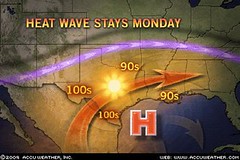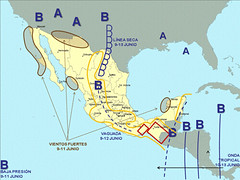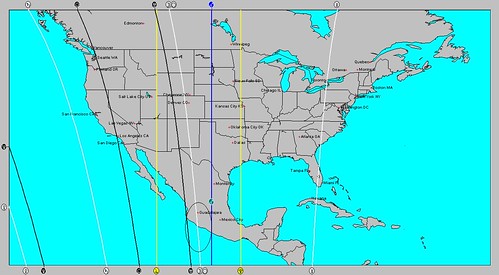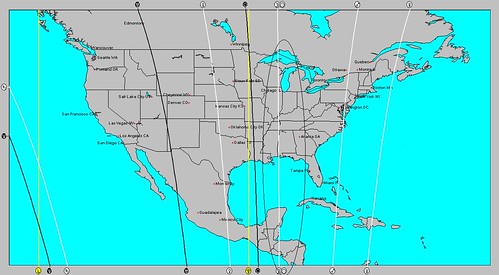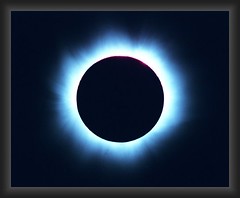
Here are more weather patterns signified by the transits of outer planets to sensitive recent solar eclipse degrees.
Solar Eclipse of February 6, 2008Oct 11-14, 2009: Jupiter lingers in conjunction to the solar eclipse degree for all of October and the last third of September. One particular time that may be important is when Jupiter turns direct on this degree. Jupiter will be at its strongest over 52 west and 15 north where a tropical system may originate.
Solar Eclipse of March 18, 2007
October 12-15, 2009: The Venus-Saturn conjunction on the 13
th will oppose the solar eclipse degree off the US West Coast at 129 west. Venus and Saturn are parallel on the 12
th. The eclipse was square Pluto. This may bring a strong storm system into the US west coast and/or tropical activity along 128 west in the tropical regions.
Solar Eclipse of July 21, 2009
October 14-17, 2009: Mars conjoins the eclipse degree over the Rockies, which will most likely result in storm formation over the area.
Solar Eclipse of July 21, 2009
October 21-24, 2009: The transit Sun will make it’s first square to the eclipse degree. The Rockies once again should see a front triggering storms or low pressure area.
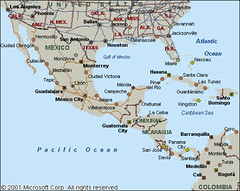
Solar Eclipse of Sept 22, 2006
Oct 22-25, 2009: Saturn conjoins the solar eclipse along 88 west longitude, which is roughly the Mississippi Valley area. Since the Gulf of Mexico, and Central America are also affected, this should be a time of strong storms and possible hurricane activity there.
Solar Eclipse of Jan 26, 2009
October 29-Nov 2, 2009: The Sun, Mars, and Mercury form a series of triggers to the solar eclipse degree which ran through the Intermountain West along 115 west longitude. First the Sun-Mars square triggers the eclipse, then Mercury squares it as it squares transit Mars. This will affect the Intermountain West with a storm system, but tropical activity could take place about 540 miles southwest of Cabo San Lucas around 115 west/17 north.

Solar Eclipse of February 6, 2008
October 30-November 2, 2009: Although Jupiter has been on this degree all month, it is now exact. The area to watch for possible tropical storm formation is in the western Atlantic around 52 west and 15 north.
Solar Eclipse of Aug 1, 2008
Nov 5-7, 2009: Mars conjoins the solar eclipse degree over the Northeast U.S. Expect storms through the area. This may also affect the Windward Islands, which may see some tropical activity.
Solar Eclipse Action for August and September 2009
Solar Eclipse Action For June and July 2009
Introduction to the Weather Alternative
How Long-Range Forecasts Are Made
Get Organized!
There may be nothing wrong with you,
The way you live, the work you do,
But I can very plainly see
Exactly what is wrong with me.
It isn't that I'm indolent
Or dodging duty by intent;
I work as hard as anyone,
And yet I get so little done,
The morning goes, the noon is here,
Before I know, the night is near,
And all around me, I regret,
Are things I haven't finished yet.
If I could just get organised!
I oftentimes have realised
Not all that matters is the man:
The man must also have a plan!
 The National Weather Service shows Hurricane Andres heading for the southern portion of the Baja California peninsula by Thursday the 25th.
The National Weather Service shows Hurricane Andres heading for the southern portion of the Baja California peninsula by Thursday the 25th. The above astro-locality map is for the New Moon of of June 22nd. Notice that the Sun and Moon were overhead there. In other words, it was high noon over the Baja at the time of the New Moon. This New Moon also was also in exact opposition to Pluto. I've drawn a box around the positions of the Sun, Moon, and Pluto.
The above astro-locality map is for the New Moon of of June 22nd. Notice that the Sun and Moon were overhead there. In other words, it was high noon over the Baja at the time of the New Moon. This New Moon also was also in exact opposition to Pluto. I've drawn a box around the positions of the Sun, Moon, and Pluto.  Looking at the New Moon from the standard astrological chart, one can see the Sun and Moon conjoining on the Midheaven while they oppose Pluto on the 4th house cusp. All three heavenly bodies square the Ascendant degree.
Looking at the New Moon from the standard astrological chart, one can see the Sun and Moon conjoining on the Midheaven while they oppose Pluto on the 4th house cusp. All three heavenly bodies square the Ascendant degree. 



